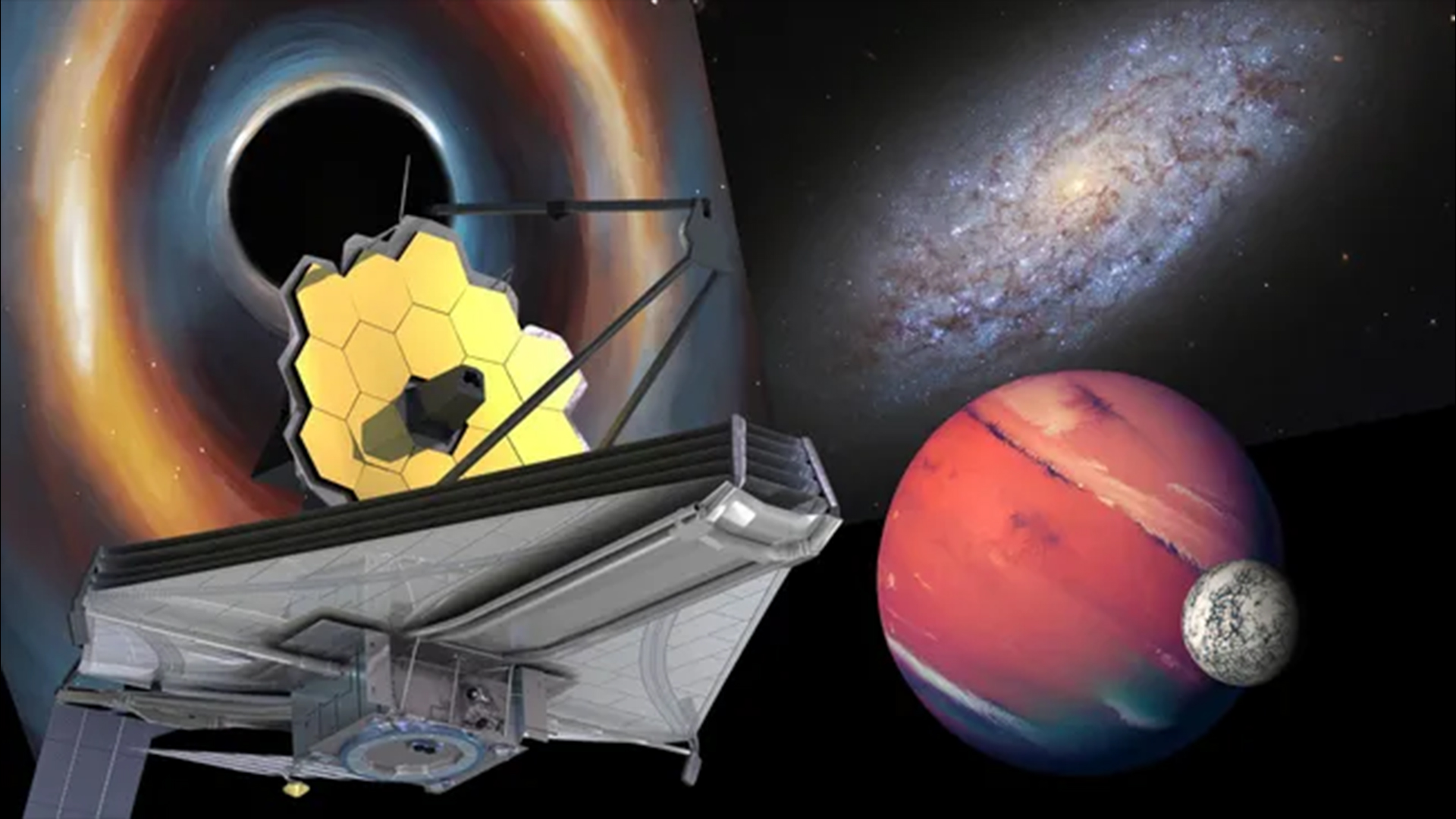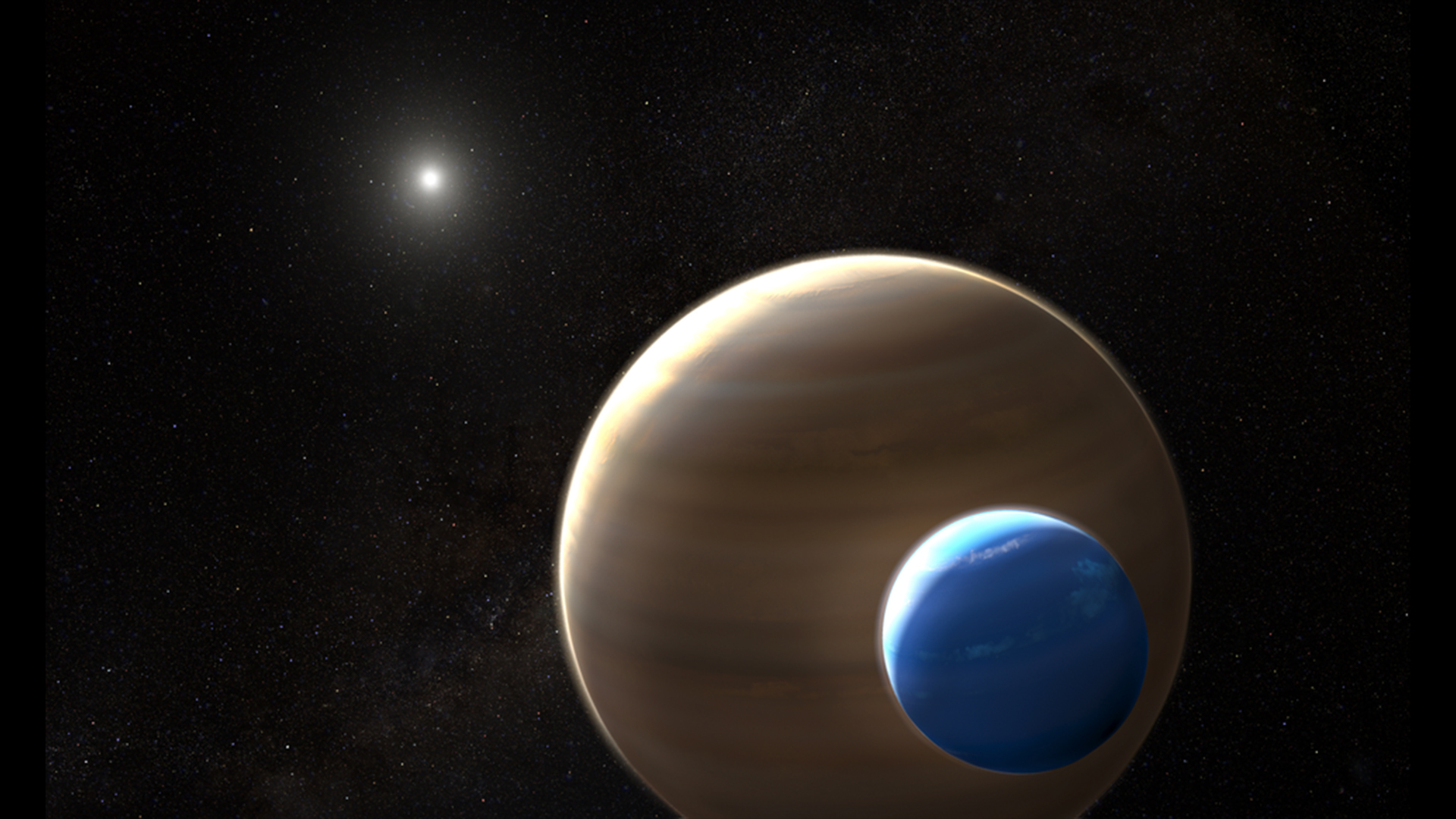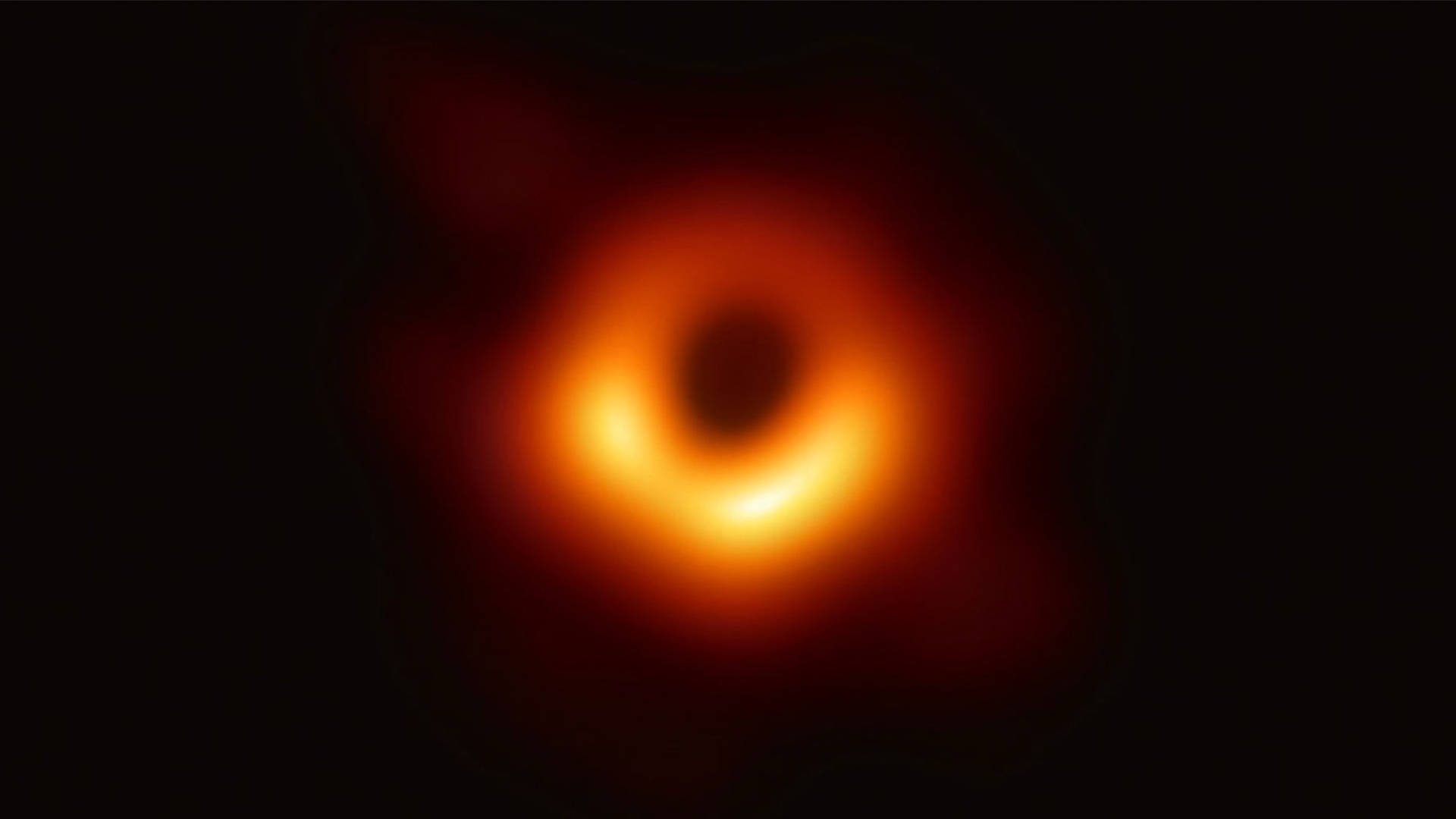James Webb telescope reveals targets for the next year, including monster black holes, exomoons, dark energy — and more
The beloved James Webb Space Telescope will soon begin working on a fascinating to-do list for 2024 and 2025, including research into black holes, alien moons, dark energy and more.

The Space Telescope Science Institute has announced which astronomy proposals have been selected to be given time with the James Webb Space Telescope over the next two years.
On Thursday (Feb. 29), the organization outlined 253 General Observers (GO) programs that will use humanity's most powerful and sensitive space telescope for a collective 5,500 hours between July 2024 and June 2025. This range is known as Cycle 3 of JWST operations.
Cycle 3 will build upon the previous two years of scientific advancements made by this $10 billion dollar telescope, which began beaming back data in 2022.
Some of the JWST's third-year targets include potential exomoons, or moons that surround exoplanets, exoplanets themselves in conjunction with their atmospheres, supermassive black holes and even distant galaxies that existed during the dawn of time. The JWST will also study large-scale structures in the cosmos to reveal details about the accelerating expansion of the universe and dark energy, the mysterious force that drives such movement.
Related: After 2 years in space, the James Webb telescope has broken cosmology. Can it be fixed?
The hunt is on for exomoons

One of the teams lucky enough to get time with the JWST during Cycle 3 will be searching for moons outside the solar system. These are known as extra-solar moons, or simply, "exomoons."
David Kipping, an assistant professor of astronomy at Columbia University, is part of the team that hopes to find moons around the exoplanet Kepler-167e in particular. This gas giant is around the size and mass of Jupiter and is located 1,115 light-years from Earth.
Sign up for the Live Science daily newsletter now
Get the world’s most fascinating discoveries delivered straight to your inbox.
"We're thrilled to get one of our proposals accepted!" Kipping told Space.com. "Our exomoon search around Kepler-167e was accepted, and it's the best target we've ever had for moon hunting."
Thus far, exomoons have proved an elusive subject for astronomers because they are hunted using the same light-blocking technique employed to spot exoplanets around stars. However, this technique is difficult enough when looking for large worlds beyond Earth — searching for little exomoons with it is immensely challenging. Not only would exomoons block far less light than the exoplanets they orbit would, but they'd also need to be in the right position at the right time.
An exomoon that's detectable would have to be orbiting its planet precisely as that planets crosses, or "transits," the face of its parent star to obscure some light when viewed from our vantage point in the cosmos. That obstruction would be detected by scientists' equipment, which would allow them to reverse-calculate that an exoplanet (or potentially exomoon) gave rise to it.
Kipping is hoping that, by focusing on Kepler-167e with the JWST's Near Infrared Imager and Slitless Spectrograph (NIRISS), he and his team can make the first undisputed detection of an exomoon. "This is hopefully just the beginning of the exomoon revolution. New worlds that will surely hold some remarkable secrets," Kipping said.
Of course, the JWST's Cycle 3 GO projects also include a wealth of investigations focusing on exoplanets themselves and not just their potential moons. This includes a few that wish to determine whether some exoplanets have the conditions needed to support life as we know it.
Among those exoplanet habitability projects is one called "Constraining the atmosphere of the terrestrial exoplanet TOI-4481b." This will use the JWST's Mid-Infrared Instrument (MIRI) for 16 hours to determine if a roughly Jupiter-mass exoplanet, which orbits a star around half as massive as the sun that sits some 39 light-years away, has been able to hang on to its atmosphere.
The result could serve as a first step in understanding the habitability of rocky planets and establishing whether M-type stars, also known as red dwarfs, have terrestrial planets with significant atmospheres. This is important in the search for life beyond Earth because red dwarfs are the most common stars in the Milky Way.
Seeking out supermassive black holes

Astronomers widely believe the majority of our universe's large galaxies have supermassive black holes in their hearts with masses as great as millions, or even billions, of suns. Some of these supermassive black holes are actively swallowing gas and dust that surrounds them in disks of matter called accretion disks.
These monster black holes' gravitational influences are thought to heat the material in those accretion disks, causing them to emit bright radiation across the electromagnetic spectrum and create regions called Active Galactic Nuclei (AGN). Additionally, any matter that isn't swallowed by the black hole can be channeled to its poles, where it is blasted out as jets of particles traveling at speeds approaching light. When that happens, the phenomenon is a called a quasar.
The violent conditions of these events make AGNs and quasars the brightest objects in the universe, often luminous enough to outshine the combined light of every star in the galaxies around them. Our theoretical understanding of supermassive black holes has burgeoned since the Event Horizon Telescope (EHT) revealed the first image of a black hole, the supermassive black hole at the heart of the galaxy Messier 87 (M87), in 2019.
And the JWST's Cycle 3 missions will further contribute to this knowledge.
The JWST Cycle 3 supermassive black hole observation programs include the investigation of quasars in the early universe and the nature of the first black holes. Scientists hope to understand how those black holes may have influenced the growth of galaxies over billions of years.
The JWST's observations of supermassive black holes in the early universe could also reveal how these cosmic titans grew to the tremendous masses scientists observe — before the universe was even 1 billion years old. Such a question can be answered by using MIRI to investigate if a giant molecular cloud that existed around 13.2 billion years ago could have directly collapsed, birthing a "heavy black hole seed" that would account for a rapid growth mechanism.
Xavier Calmet is a researcher at the University of Sussex who investigates the intersection between black holes and quantum mechanics. He told Space.com he is particularly excited to see the JWST focusing on supermassive black holes and AGNS.
"The JWST Cycle 3 projects are very exciting," Calmet explained. "Given my own research interests, I am particularly eager to see what we will learn about black holes."
The James Webb Space Telescope goes big
One of the primary roles of the JWST is investigating objects in the early universe. The powerful space telescope has this capacity because the expansion of the universe stretches wavelengths of light from distant objects as this light travels toward us, moving the wavelengths toward the "red end" of the electromagnetic spectrum.
The longer that light has traveled to reach us, the more redshifted the light has become. This means light that has been traveling for around 12 billion years is extremely redshifted, all the way into the infrared region of the electromagnetic spectrum and outside the visible range we can see with the unaided eye. Effectively, infrared light is invisible to us. The JWST, however, is capable of observing this infrared light and thus helps to investigate the first stars and earliest galaxies, something it will continue to do in 2025 with several Cycle 3 GO projects.
Luz Angela Garcia is a cosmologist at the Universidad ECCI in Columbia who focuses on how dark energy expands the cosmos at an accelerating rate, which in turn helps with investigations regarding the universe's evolution. She is particularly enthusiastic about GO projects that will look at an era of cosmic evolution called the epoch of reionization, which occurred around 500 million years after the Big Bang.
During this period, neutral atoms of hydrogen populating the cosmos were ionized by radiation that stripped away their electrons and left them as ionized hydrogen, or hydrogen ions. Studying high-redshift galaxies can reveal more about this crucial stage in cosmic evolution, including how the first galaxies acted as the source of this ionizing radiation.
"Some of the proposals that catch my interest are 'Understanding galaxy formation at cosmic dawn,' 'Galactic Winds in the Early Universe' and 'Dead or alive? Unveiling the nature of massive galaxies in the early Universe,'" Garcia told Space.com. "All of these accepted projects seek to identify and characterize galaxies that are the drivers of the epoch of reionization.
"Most of these proposals focus on studying the properties of the first galaxies in the universe — very high-redshift systems that need spectroscopic confirmation."
This is just the tip of the celestial iceberg when it comes to the range of topics Cycle 3 GO projects will cover. Between 2024 and 2025, astronomers will also train telescopes on distant stars to better understand stellar physics and populations, as well as examine the gas that exists between stars that can become the building blocks of the next generation of stars and planets. Though the JWST was designed with the study of distant objects in mind, Cycle 3 will also see the observatory used to study bodies within our own solar system. These will include hunting for the source of gas plumes coming from Saturn's moon Enceladus, investigating the dynamics of the Uranus' rings and characterizing icy objects that exist in the Kuiper Belt at the very edge of the solar system.
Looking beyond JWST Cycle 3, the call for Cycle 4 GO proposals will go out on August 1, 2024, with a deadline set for Oct. 16 this year. The Cycle 4 Telescope Allocation Committee (TAC) review will run between Feb. 3 and Feb.12, 2025, with selections revealed around March 5 next year. JWST Cycle 4 GO programs will then begin making observations of the cosmos on July 1, 2025.
A full list of accepted Cycle 3 JWST programs is available on the STScI website.
Originally posted on Space.com.
Robert Lea is a science journalist in the U.K. who specializes in science, space, physics, astronomy, astrophysics, cosmology, quantum mechanics and technology. Rob's articles have been published in Physics World, New Scientist, Astronomy Magazine, All About Space and ZME Science. He also writes about science communication for Elsevier and the European Journal of Physics. Rob holds a bachelor of science degree in physics and astronomy from the U.K.’s Open University











